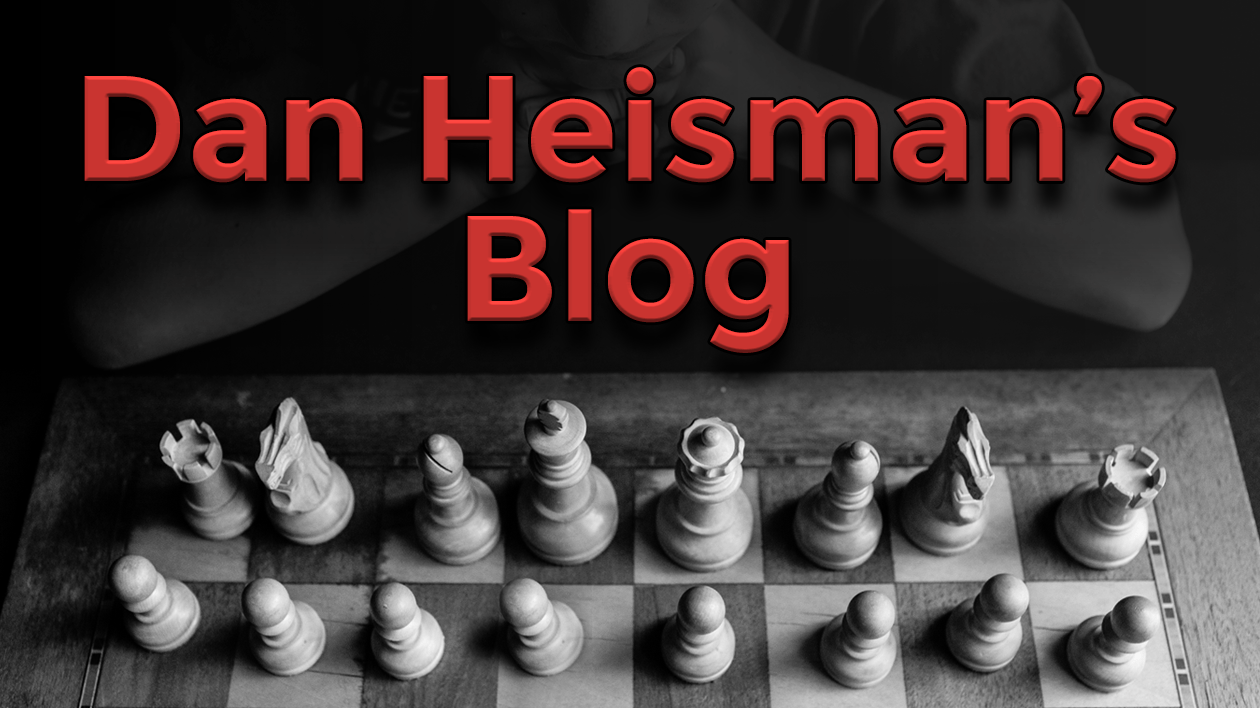
What's the Secret Behind Chess?
Yes, "What's the secret behind chess?" was one of the questions on the "Q&A with Coach Heisman" show tonight.
Unlike "What's the best way to learn X?", a popular question where my answer is usually "Do/play X with strong players (at least hang our with them!) and analyze X with them; ask questions and listen to their answers", "What's the secret behind chess?" is a little more, shall we say, mysterious 
So I took the question literally (we like to have a little fun on the show), and answered "Well, one thing behind a chess board is the back of the board, so the secret of chess is what is written on the back of the board. For example, if it's a secret what you think of your opponent, write it on the back of the board and he won't see it!" 
Speaking of secrets, GM Soltis wrote in his fine book Grandmaster Secrets: Openings that there are several reasons why it usually doesn't make sense for non-professional players to play the same openings that the top professional players do. I completely agree with him. Yet I consistently get questions like "Is X a good opening?" (For a more complete discussion of how I feel about this, see "What's a Good Opening?") I guess the general feeling is that if Magnus Carlsen or Fabiano Caruana don't play the Latvian Opening, it can't be good for you or anyone.
Similarly, many feel that if the computer says that White gets a 0.3 pawn advantage in the main line of one opening instead of 0.2 in another line then of course the former is a bad opening, too.
Somehow many learning players group every variation of one opening into one concept about the entire opening. In other words, no matter how complicated variation X is of the Caro-Kann, the Caro-Kann is a dull opening and the Sicilian an "exciting" and "aggressive" one. Yet the Sicilian consists of many, many variations, and Open Sicilians, while markedly dynamic and imbalanced, vary quite a bit in style and substance from many Anti-Sicilians (say the Rossolimo or Moscow Variations). You can't treat them all like they are one opening with one opening reputation.
Let me quote GM Lev Alburt and Al Lawrence from their book Chess Rules of Thumb: Rule of Thumb #283: "Any opening is that you know well is good no matter what it's reputation." - that was a quote from some guy Dan Heisman. It's not strictly true, of course, but at the class level it's a lot more true and helpful than simply mimicing the openings of the best players.
Speaking of openings, someone asked "What's the best opening?" That depends on your definition of "best", of course, but my answer was the best opening was the Fool's mate, because it's the only opening that allows one player to checkmate on the second move, and you can't do better than that:
As a question during the second part of the show, someone sent me the diagram:
And I immediately thought it was the famous problem:
It took me a minute to realize that the rooks were reversed, which makes all the difference in the world!
Two shows ago (we have a show the first Friday of each month at 5-6:30 PM ET) I showed the second diagram. Black can only draw with 1...Kg7!, avoiding skewer tricks like 1...Ke7?? 2.Rh8! wins.
But the first diagram, the one presented to me on the show, only looks very similar. There are no tricks, so that's why it's not nearly as well known. I just gave the position to the Shredder Tablebase, and it confirmed the answer I gave on the show: easy draw. Black just wanders his king over toward the white pawn and there's not much White can do about it. If he threatens to skewer with a move like Rh1 at some point, Black simply does not capture the pawn yet with Rxa7?? allowing Rh7+, but instead continues to move the king closer to the pawn: draw. Makes me wonder if the viewer actually meant to give me the second diagram, having missed the show two months ago! 
Just for the record, the show has the following format, to encourage "diagram" questions and answers:
- First 30 minutes is devoted to questions about opening positions (not opening choices or opinions - see part #3)
- Second 30 minutes is devoted to positions other than the opening: middlegame, endgame, puzzles, etc.
- Final 30 minutes is Open to any question about chess. So if you have a question about openings that does NOT involve a specific position, it properly belongs here and not in #1
Some caveats about viewer questions:
- Don't ask a question about which they write chapters of books or entire books. I can only devote a minute or three to each answer, and asking a question which would "hog" an entire portion of the show is not fair to the viewers and other questioners.
- Limit yourself to one question per show. Let others get their questions in, too. If I think we are running dry on questions (certainly not the case this month), then I will open up the show to multiple questions from one viewer.
- Don't repeat your question just because I have not gotten to it yet. I am scrolling down one question at a time. Therefore, by the middle of the show, I may be 20 minutes behind the newest posted questions. Posting your question again just slows down the show for everyone. I will answer every legitimate question I can get to, so if I get to your question I will answer it and posting it again won't help. If you ask a silly question which does not deserve to be read on the show, posting that multiple times is even worse (thanks to the mods for helping me with that!)

